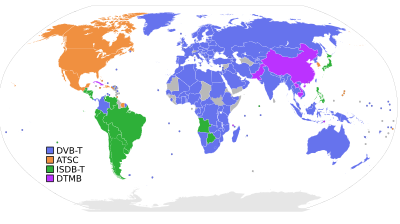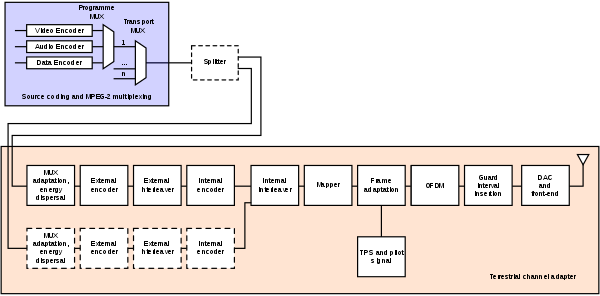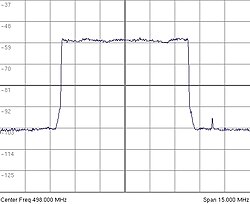DVB-T: Difference between revisions
| Line 256: | Line 256: | ||
== External links == |
== External links == |
||
* [http://www.imageTune.com/ imageTune DVB-H] |
|||
* [http://www.dvb.org/ Website of the DVB Project] |
* [http://www.dvb.org/ Website of the DVB Project] |
||
* [http://www.dvb-h.org/ DVB-H.org] |
* [http://www.dvb-h.org/ DVB-H.org] |
||
Revision as of 07:27, 5 July 2008
DVB-T stands for Digital Video Broadcasting – Terrestrial; it is the DVB European consortium standard for the broadcast transmission of digital terrestrial television. This system transmits a compressed digital audio/video stream, using OFDM modulation with concatenated channel coding (i.e. COFDM). The adopted source coding methods are MPEG-2 and, more recently, H.264/MPEG-4 AVC.
DVB-T is a method of transmission that is being adopted primarily for digital television broadcasting, for example in the UK, Freeview. OFDM works by splitting the wide-band digital signal into a large number of slower digital streams, and then transmitting them all on a set of closely spaced adjacent carrier frequencies, rather than just one. Typically, transmitters miles apart can be operated on the same set of frequencies and a receiver in between will demodulate correctly the signal coming from both.
OFDM is also used for digital radio broadcasting.

DVB-T2
In March 2006 DVB decided to study options for an upgraded DVB-T standard. In June 2006, a formal study group named TM-T2 (Technical Module on Next Generation DVB-T) was established by the DVB Group to develop an advanced modulation scheme that could be adopted by a second generation digital terrestrial television standard, to be named DVB-T2.[1]
According to the commercial requirements and call for technologies[2] issued in April 2007, the first phase of DVB-T2 will be devoted to provide optimum reception for stationary (fixed) and portable receivers (i.e., units which can be nomadic, but not fully mobile) using existing aerials, whereas a second and third phase will study methods to deliver higher payloads (with new aerials) and the mobile reception issue. The novel system should provide a minimum 30% increase in payload, under similar channel conditions already used for DVB-T. Expected technologies will probably include:
- LDPC/BCH code forward error correction, in compliance with the technique already adopted in the DVB-S2 satellite standard, and other newer standards.
- Optional use of MIMO and other antenna diversity system.
- Improved methods for reducing peak power to the antenna (PAPR reduction).
- More than 8k carriers. 16k and 32k carriers would minimize the overhead when single frequency networks are used. Present SFN networks are likely to see gains of 50% or more in net bit rate.
- Improved channel estimation. Less overhead from fewer pilot carriers is likely.
- 30% larger distance between adjacent transmitters possible with SFN. Much larger SFN.
- Variable coding and modulation.
- Flexible multiplexing; several concurrent transport streams including Generic Stream Encapsulation for IP.
- New DVB-T2 receivers are expected to be able to receive DVB-T, but DVB-T receivers will not receive DVB-T2 as hardware changes are needed. Firmware upgrades will not be enough.
It is expected that work on the DVB-T2 specification will be completed and passed to ETSI for standardization during 2008. First draft standard is expected by the end of June 2008. Market deployment is expected for 2009.
The BBC, ITV, Channel 4 and Five have agreed with the regulator Ofcom to convert one UK multiplex (B, or PSB3) to DVB-T2 to increase capacity for HDTV via DTT.[3] They expect the first TV region to use the new standard will be Granada in November 2009 (with existing switched over regions being changed at the same time). It is expected that over time there will be enough DVB-T2 receivers sold to switch all DTT transmissions to DVB-T2, and MPEG-4 Part 10.
Ofcom recently published its final decision for HDTV using DVB-T2 and MPEG-4 [4]: BBC HD will have one HD slot after DSO at Granada and ITV, C4 and Five will compete for the two remaining HD slots from 2009 until 2012.
The DVB-T2 draft standard
From documents published on the Internet by RAI and others, the following characteristics are expected for the T2 standard:[5]
- Modulation will be standard COFDM in one of the modes QPSK, 16-QAM, 64-QAM, or 256-QAM (but not 128-QAM).
- OFDM modes will be 1k, 2k, 4k, 8k, 16k and 32k. The symbol length for 32k mode will be about 4 ms.
- Guard intervals will be 1/128, 1/32, 1/16, 19/256, 1/8, 19/128, and 1/4. (For 32k mode, the maximum is 1/8.)
- FEC will be LDPC and BCH (as in DVB-S2), with rates 1/2, 3/5, 2/3, 3/4, 4/5, and 5/6.
- There will be fewer pilots, in 8 different pilot-patterns, and equalization will be based also on the RAI CD3 system.
- In the 32k mode, a larger part of the standard 8 Mhz channel can be used, adding about 2% extra capacity.
- DVB-T2 will be specified for 1.7, 5, 6, 7, 8, and 10 MHz channel bandwidth.
- MISO (Multiple-Inputs Single-Output) may be used (Alamouti scheme), but MIMO will not be used. Diversity receivers can be used (as they are with DVB-T).
- Bundling of more channels into a SuperMUX (called TFS) is not in the standard, but may be added later.
An example for a UK MFN DVB-T profile (QAM64, 2k, CR2/3, GI1/32) and a DVB-T2 equivalent (QAM256, 32k, CR3/5, GI1/128) shows an increase in bit rate from 24.13 Mbit/s to 35.4 Mbit/s (+46.5%).
Another example is an Italian SFN DVB-T profile (QAM64, 8k, CR2/3, GI1/4) and a DVB-T2 equivalent (QAM256, 32k, CR3/5, GI1/16):
it shows an increase in bit rate from 19.91 Mbit/s to 33.3 Mbit/s (+67%).
- Status of the DVB-T2 specification (early April 2008)
- The DVB-T2 physical layer specification is complete and there will be no further technical enhancements.
- The receiver VLSI chip design can be started with confidence in stability of specification (the DVB internal standard document is available to all DVB members including the leading chip companies)
- Draft PSI/SI (program and system information) specification document agreed with the DVB-TM-GBS group.
Some information can be found in this document DVB-T2 Fact Sheet June 2008
The DVB-T2 draft standard - EN 302 755 - has been handed over to The European Telecommunications Standards Institute -ETSI - by DVB.ORG June 20. 2008
(ETSI timetable DVB-T2).
The 'ETSI process' will take until April 25. 2009 when the final standard will be published.
The DVB-T2 draft standard was ratified by the DVB Steering Board June 26 2008.
The draft EN 302 755 DVB-T2 standard is published on the dvb.org homepage as 'DVB-T2 standard BlueBook'.
Testing the DVB-T2 standard
The first test from a real TV-transmitter was performed by the BBC Research & Innovation in the last weeks of June 2008 [1] using channel 53 from the Guildford transmitter southwest of London. The BBC had developed and built the modulator/demodulator prototype in parallel with the DVB-T2 standard being drafted. Several other groups in Europe are expected to join the DVB-T2 test program shortly.
Technical description of a DVB-T transmitter

With reference to the figure, a short description of the signal processing blocks follows.
- Source coding and MPEG-2 multiplexing (MUX): compressed video, compressed audio, and data streams are multiplexed into PSs (Programme Streams). One or more PSs are joined together into an MPEG-2 TS (MPEG-2 Transport Stream); this is the basic digital stream which is being transmitted and received by home Set Top Boxes (STB). Allowed bitrates for the transported data depend on a number of coding and modulation parameters: it can range from about 5 to about 32 Mbit/s (see the bottom figure for a complete listing).
- Splitter: two different TSs can be transmitted at the same time, using a technique called Hierarchical Transmission. It may be used to transmit, for example, a standard definition SDTV signal and a high definition HDTV signal on the same carrier. Generally, the SDTV signal is more robust than the HDTV one. At the receiver, depending on the quality of the received signal, the STB may be able to decode the HDTV stream or, if signal strength lacks, it can switch to the SDTV one (in this way, all receivers that are in proximity of the transmission site can lock the HDTV signal, whereas all the other ones, even the farthest, may still be able to receive and decode an SDTV signal).
- MUX adaptation and energy dispersal: the MPEG-2 TS is identified as a sequence of data packets, of fixed length (188 bytes). With a technique called energy dispersal, the byte sequence is decorrelated.
- External encoder: a first level of error correction is applied to the transmitted data, using a nonbinary block code, a Reed-Solomon RS (204, 188) code, allowing the correction of up to a maximum of 8 wrong bytes for each 188-byte packet.
- External interleaver: convolutional interleaving is used to rearrange the transmitted data sequence, in such a way that it becomes more rugged to long sequences of errors.
- Internal encoder: a second level of error correction is given by a punctured convolutional code, which is often denoted in STBs menus as FEC (Forward error correction). There are five valid coding rates: 1/2, 2/3, 3/4, 5/6, and 7/8.
- Internal interleaver: data sequence is rearranged again, aiming to reduce the influence of burst errors. This time, a block interleaving technique is adopted, with a pseudo-random assignment scheme (this is really done by two separate interleaving processes, one operating on bits and another one operating on groups of bits).
- Mapper: the digital bit sequence is mapped into a base band modulated sequence of complex symbols. There are three valid modulation schemes: QPSK, 16-QAM, 64-QAM.
- Frame adaptation: the complex symbols are grouped in blocks of constant length (1512, 3024, or 6048 symbols per block). A frame is generated, 68 blocks long, and a superframe is built by 4 frames.
- Pilot and TPS signals: in order to simplify the reception of the signal being transmitted on the terrestrial radio channel, additional signals are inserted in each block. Pilot signals are used during the synchronization and equalization phase, while TPS signals (Transmission Parameters Signalling) send the parameters of the transmitted signal and to unequivocally identify the transmission cell. It should be noted that the receiver must be able to synchronize, equalize, and decode the signal to gain access to the information held by the TPS pilots. Thus, the receiver must know this information beforehand, and the TPS data is only used in special cases, such as changes in the parameters, resynchronizations, etc.

- OFDM Modulation: the sequence of blocks is modulated according to the OFDM technique, using 2048, 4096, or 8192 carriers (2k, 4k, 8k mode, respectively). Increasing the number of carriers does not modify the payload bit rate, which remains constant.
- Guard interval insertion: to decrease receiver complexity, every OFDM block is extended, copying in front of it its own end (cyclic prefix). The width of such guard interval can be 1/32, 1/16, 1/8, or 1/4 that of the original block length. Cyclic prefix is required to operate single frequency networks, where there may exist an ineliminable interference coming from several sites transmitting the same program on the same carrier frequency.
- DAC and front-end: the digital signal is transformed into an analog signal, with a digital-to-analog converter (DAC), and then modulated to radio frequency (VHF, UHF) by the RF front-end. The occupied bandwidth is designed to accommodate each single DVB-T signal into 5, 6, 7, or 8 MHz wide channels. The base band sample rate provided at the DAC input depends on the channel bandwidth: it is samples/s, where is the channel bandwidth expressed in Hz.
| Available bitrates (Mbit/s) for a DVB-T system in 8 MHz channels | |||||
|---|---|---|---|---|---|
| Modulation | Coding rate | Guard interval | |||
| 1/4 | 1/8 | 1/16 | 1/32 | ||
| QPSK | 1/2 | 4.976 | 5.529 | 5.855 | 6.032 |
| 2/3 | 6.635 | 7.373 | 7.806 | 8.043 | |
| 3/4 | 7.465 | 8.294 | 8.782 | 9.048 | |
| 5/6 | 8.294 | 9.216 | 9.758 | 10.053 | |
| 7/8 | 8.709 | 9.676 | 10.246 | 10.556 | |
| 16-QAM | 1/2 | 9.953 | 11.059 | 11.709 | 12.064 |
| 2/3 | 13.271 | 14.745 | 15.612 | 16.086 | |
| 3/4 | 14.929 | 16.588 | 17.564 | 18.096 | |
| 5/6 | 16.588 | 18.431 | 19.516 | 20.107 | |
| 7/8 | 17.418 | 19.353 | 20.491 | 21.112 | |
| 64-QAM | 1/2 | 14.929 | 16.588 | 17.564 | 18.096 |
| 2/3 | 19.906 | 22.118 | 23.419 | 24.128 | |
| 3/4 | 22.394 | 24.882 | 26.346 | 27.144 | |
| 5/6 | 24.882 | 27.647 | 29.273 | 30.160 | |
| 7/8 | 26.126 | 29.029 | 30.737 | 31.668 | |
Technical description of the receiver
The receiving STB adopts techniques which are dual to those ones used in the transmission.
- Front-end and ADC: the analog RF signal is converted to base-band and transformed into a digital signal, using an analog-to-digital converter (ADC).
- Time and frequency synchronization: the digital base band signal is searched to identify the beginning of frames and blocks. Any problems on the frequency of the components of the signal are corrected, too. The property that the guard interval at the end of the symbol is placed also at the beginning is exploited to find the beginning of a new OFDM symbol. On the other hand, continual pilots (whose value and position is determined in the standard and thus known by the receiver) determine the frequency offset suffered by the signal. This frequency offset might have been caused by Doppler effect, inaccuracies in either the transmitter or receiver clock, and so on.
- Guard interval disposal: the cyclic prefix is removed.
- OFDM demodulation
- Frequency equalization: the pilot signals equalize the received signal.
- Demapping
- Internal deinterleaving
- Internal decoding: uses the Viterbi algorithm.
- External deinterleaving
- External decoding
- MUX adaptation
- MPEG-2 demultiplexing and source decoding
Countries and territories using DVB-T[6]
Americas
 Argentina (experimental)
Argentina (experimental) Uruguay (decided in September 2007, but not effective yet)
Uruguay (decided in September 2007, but not effective yet) Colombia (experimental)[citation needed]
Colombia (experimental)[citation needed]
Europe
 Albania
Albania Andorra
Andorra Austria
Austria Belgium
Belgium Bulgaria (experimental)
Bulgaria (experimental) Belarus (experimental)
Belarus (experimental) Croatia
Croatia Czech Republic
Czech Republic Cyprus
Cyprus Denmark (See DVB-T in Denmark.)
Denmark (See DVB-T in Denmark.)
 Estonia
Estonia Finland
Finland France
France Germany
Germany Greece (experimental)
Greece (experimental) Hungary (experimental)
Hungary (experimental) Iceland
Iceland
 Ireland (See DVB-T in Ireland.)
Ireland (See DVB-T in Ireland.) Italy
Italy Latvia (experimental)
Latvia (experimental) Lithuania
Lithuania Luxembourg
Luxembourg Malta
Malta Montenegro
Montenegro Netherlands
Netherlands Norway (uses MPEG-4 video)
Norway (uses MPEG-4 video) Poland (experimental)
Poland (experimental) Portugal
Portugal Romania
Romania Russia (experimental)
Russia (experimental) Slovakia (experimental)
Slovakia (experimental) Serbia
Serbia Slovenia
Slovenia Spain
Spain Sweden (See DVB-T in Sweden.)
Sweden (See DVB-T in Sweden.) Switzerland
Switzerland Turkey (experimental)
Turkey (experimental) United Kingdom (See DVB-T in United Kingdom.)
United Kingdom (See DVB-T in United Kingdom.) Ukraine (experimental, Kyiv only, 20 channels)
Ukraine (experimental, Kyiv only, 20 channels)
Asia/Australasia
 Australia
Australia India
India Indonesia
Indonesia Iran (pilot service)
Iran (pilot service) Israel
Israel Malaysia (experimental)
Malaysia (experimental) Myanmar
Myanmar New Zealand (see Freeview)
New Zealand (see Freeview) Philippines (experimental;NTC announced DVB-T as a DTT standard this June)
Philippines (experimental;NTC announced DVB-T as a DTT standard this June) Singapore
Singapore Saudi Arabia
Saudi Arabia Sri Lanka (pilot service [7])
Sri Lanka (pilot service [7]) Taiwan
Taiwan Vietnam
Vietnam United Arab Emirates
United Arab Emirates
Africa
See also
- ATSC (Advanced Television Systems Committee, North American Standard)
- Digital audio broadcasting (low bitrate video suitable for moving receivers)
- DTV channel protection ratios
- DVB over IP
- Interactive television
- Digital terrestrial television
- DMB-T - Digital Multimedia Broadcast-Terrestrial
- ISDB - Integrated Services Digital Broadcasting
- OFDM system comparison table
- Spectral efficiency comparison table
Notes
- ^ TM-T2. Second Generation DVB-T, DVB.org
- ^ DVB - Digital Video Broadcasting - DVB-T2
- ^ "3 Freeview HD channels will start 2009 – ukfree.tv – independent digital television and switchover advice, since 2002". Retrieved 2007-11-25.
- ^ "Ofcom Statement on DTT future, announced on April 3, 2008". Retrieved 2008-04-09.
- ^ Presentation given by Dr. Morello RAI research centre, Rome, April 3, 2008]
- ^ Official information taken from the DVB website
- ^ Lankanewspapers.com, Dialog TV launches another South Asia`s first DVBT, 2008-01-24. Retrieved on 2008-01-26.
References
- ETSI Standard: EN 300 744 V1.5.1, Digital Video Broadcasting (DVB); Framing structure, channel coding and modulation for digital terrestrial television, available at ETSI Publications Download Area (This will open ETSI document search engine, to find the latest version of the document enter a search string; free registration is required to download PDF.)


